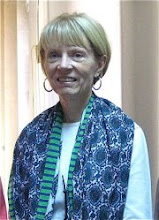Reweaving Traditional Fibers
 Women Carpet Weavers
Women Carpet WeaversCarpet weaving is a major source of income for women in Djerba. I visited the Minisouq in the center of Houmt Souk to see their work firsthand. The Minisouk is a cooperative, selling all sorts of crafts (pottery, jewelry, leather bags, and jellabahs) in a converted caravanserai. A caravanserai was a combination inn and warehouse used by traveling merchants as a stopover and place to store their goods. Men slept on the upper level, animals below. Nowadays, a large room on the upper level is filled with looms, where about eight women sit weaving carpets. They work from 8 AM to 12 PM and from 4-6 PM. They are paid 300 Tunisian Dinars ($237.78) per month plus transportation. They also receive a commission, when the cooperative settles its accounts at the end of each year. In addition to these women, some work at home due to the convenience and send their completed carpets to the cooperative for sale. Women do not run the cooperative; but it provides them a place to work and make some money.
Carpet weaving, at present, bridges the traditional and modern worlds. Customarily, rugs and kilims (rugs with richly colored geometric patterns, woven like tapestry, with no pile) were made for family use from wool, goat, or camel hair, using dyes extracted from indigenous plants and insects. These early carpets were adapted to nomadic life. In sedentary communities, rugs were used as floor coverings in homes and sacred places. Designs varied according to the weaver and region. Producing these carpets for sale–largely to tourists– is an innovation, a departure from the conventional practice. Women are leaving the home or spending a large part of their day at a trade at which they alone are skilled and which matches their accepted image. They can, thus, engage in a cash-driven economy and retain the cover of respectability.
For a couple of days, the sea was placid, a sheet of shimmering ripples with little variation. Today, some whitecaps are back, foamy swells following each other to the shore. I don’t need a CD with the sound of waves; their resonance is available whenever I go out the door or open the window.


0 Comments:
Post a Comment
<< Home